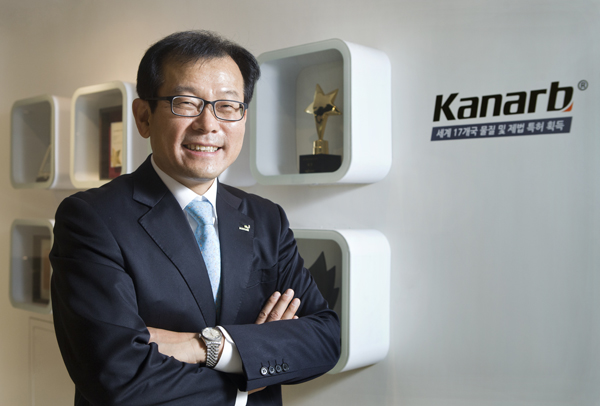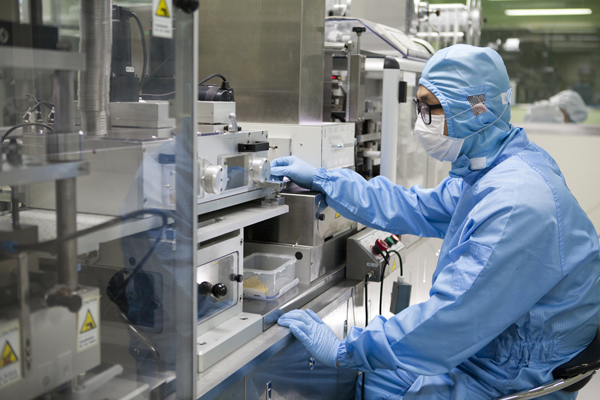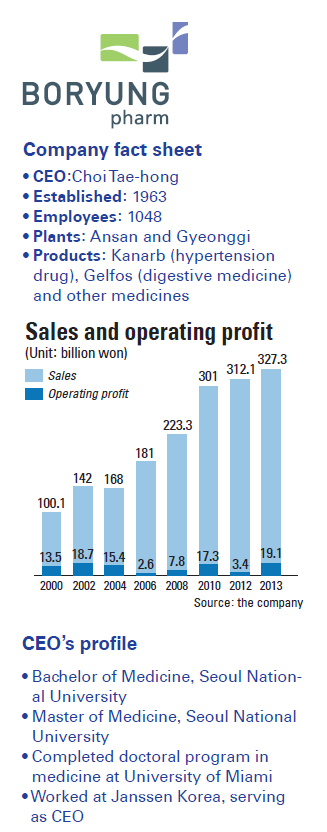CEO pushes boundaries of Korean pharmaceuticals

Choi Tae-hong, at the headquarters of Boryung Pharm in central Seoul, says the company will expand sales of hypertension drug Kanarb overseas. By Park Sang-moon
Market expansion, however, didn’t necessarily translate into qualitative growth in the pharmaceutical industry.

Boryung's Ansan factory in Gyeonggi manufacturesand conducts research and development. Provided by the company
The risk-averse orientation caused Choi Tae-hong, former president of Janssen Korea, to underestimate the competitiveness and potential of domestic drug companies.

The success of Boryung Pharm caused him to join the company as CEO in 2013 when approached after a 25-year stint at Janssen Korea.
Choi is looking abroad to drive future sales growth of Kanarb and has signed licensing deals with 15 countries, including China and Brazil.
Even when a local pharmaceutical company manages to develop a new type of drug, it rarely beats out competitive drugs made by multinationals.
But Kanarb was the most-prescribed hypertension medicine in 2012 in the Korean market, outperforming well-known drugs such as Diovan by Novartis and AstraZeneca’s Atacand.
“Even if local pharmaceutical companies manufacture a novel drug, many of them fail to rake in significant profits because of their inability to market and commercialize the medications,” Choi says. “I want to prove Boryung can be different.”
Kanarb sales exceeded 10 billion won ($9 million) in its first year and sales increased threefold to 30 billion won last year, making Kanarb the new best-selling drug made in Korea. Of the 21 new drugs developed by local companies, only three have seen sales of more than 10 billion won in a year.
Kanarb’s success lies in its efficacy and safety as proven in a series of clinical trials, Choi says.
“The most important effect of the medication is the lowering of blood pressure,” says the CEO .
He stressed that clinical tests rated Kanarb highly for the speed with which the drug takes effect, which reduces the risk of side effects.
Kanarb’s proven effectiveness and safety is precisely why Choi is confident the medicine will sell well overseas.
Kanarb is set to break into the Central and South American markets after Boryung signed a $26 million contract with Mexico’s Stendhal in July to supply the high blood pressure drug to 13 countries. Boryung later signed other contracts for distribution in Brazil and Russia.
Under the license-out contract with Stendhal, $23 million worth of Kanarb will be exported through 2020. The drug manufacturer also is actively seeking overseas partners to sell Kanarb in the United States and Europe.
In September, Boryung shipped the first batch of Kanarb to Mexico after receiving the approval from the country’s pharmaceutical regulator. Kanarb will be sold in Mexico under the name Arahkor, meaning “ARB from Korea.” ARB is the most widely used type of hypertension medication.
Choi says his strategic approach is to focus on Central and South American countries, which tend to recognize clinical trials conducted in more advanced countries.
“Since Mexico recognized the results of earlier clinical trials in Korea,” says Choi, “we could speed up the process of approval and marketization.”
But he added that countries such as the United States and Japan require foreign pharmaceutical companies to undergo separate, often more rigorous, clinical trials.
Latin American countries are especially promising for sales of hypertension medication.
More than 21 million Mexicans suffer from high blood pressure, according to Boryung, and the number is steadily on the rise.
The value of Central and South American pharmaceutical market was estimate at approximately $62.9 billion based on 2011, and the market is forecast to post an annual average growth rate of 10 percent to 13 percent.
Clinching deals with Mexico and Brazil is notable, given that the two countries account for 57 percent in the Central and South America market.
“Stendhal has high hopes for Kanarb,” says Choi. “The head of the Mexican company said it will channel more than $ 100 million into marketing Kanarb for the next five years. Stendhal recently recruited 50 marketing specialists.”
The bigger news this year was Boryung’s clinched a licensing deal with China, one of the largest and fastest-growing pharmaceutical markets in the world.
In the deal, Boryung gave Gloria Pharmaceuticals the exclusive right to sell Kanarb in China. The Chinese company paid $5.4 million up front and promised annual sales of at least $75 million.
Harbin Gloria will prepare documents required for a series of clinical trials in China, and Cho says the plan is to release Kanarb in late 2017.
“Without a doubt, China holds key to future growth, but the Chinese market can be tricky. However, we have experience selling medicine in China for more than 20 years with our signature drug Gelfos. So I can say that we have developed some knowledge and expertise in the China pharmaceutical market.”
Gelfos is designed to ease gastric pain and heartburn. With the increase in headaches that come along with a rash of heartburn and digestive problems, Gelfos, which sells in China as Fosgel, also has seen stable sales growth in Korea. But the sales record in China is almost three times that of Korea, hitting 38 billion won last year, making it the top-selling Korean-made medication in China.
“We expect the sales to grow to 50 billion won this year,” Choi says. “With the explosive population, there still are untapped opportunities in China.”
Choi, however, is wary of resting on Boryung’s achievements.
For sustainable growth in a pharmaceutical company, he stresses a corporate culture that embraces risk-taking and steady investment in research and development.
“Kanarb was in development for 10 years, and no one was sure whether it would turn out to be a success,” he says. “But Boryung went ahead with the development. Without the risk-taking, Kanarb would not have come out.”
Boryung spends about 5 percent of its sales revenue on research and development and plans to increase that to 10 percent.
“So my task is to create the environment where the company’s pharmacists pursue high-value research that holds great potential,” says Choi. “Even though the results might not be immediate.”
BY PARK EUN-JEE [ejpark@joongang.co.kr]










with the Korea JoongAng Daily
To write comments, please log in to one of the accounts.
Standards Board Policy (0/250자)